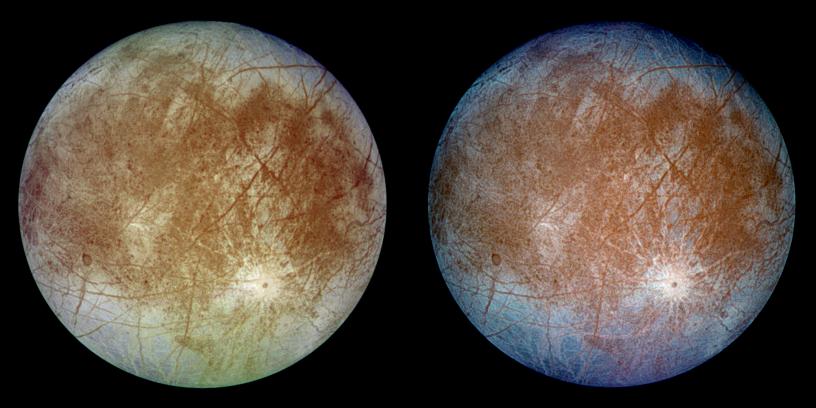
The more they look at other worlds in the Solar System, the more scientists discover that Earth isn’t as special as we earthlings like to think. Our planet has active volcanoes—but so does Jupiter’s moon Io. We have geysers—and so does Saturn’s moon Enceladus. We have lakes, rivers and rain, and so does Titan, another moon of Saturn’s.
Now a paper in the journal Nature Geoscience argues that one more geological feature thought to be unique to Earth may not be after all. Using images from the Galileo spacecraft, planetary scientists think they’ve found evidence of plate tectonics on Jupiter’s ice-covered moon Europa—a world that’s already on astrobiologists’ radar because the ocean that lies beneath the moon’s thick rind of ice could conceivably host life of some sort.
Plate tectonics is the same process that causes continents to drift slowly around on the surface of the Earth, and, says Michelle Selvans, a research geophysicist at the Smithsonian’s National Air and Space Museum, who wrote a commentary on the new research for the same journal, “we’ve never seen this anywhere else.”
If plates are indeed shifting on the Jovian moon, it explains a longstanding mystery. Europa’s surface is crisscrossed with cracks where the thick ice has spread apart and the resulting gaps have been filled in by new slushy ice oozing up from the water deep below. “The fundamental question,” says the paper’s lead author, University of Idaho planetary scientist Simon Kattenhorn, “is how you can keep adding new surface without getting rid of old surface?
That’s wouldn’t be a problem if Europa were simply growing in size, but, writes Selvans, that is “unlikely.” (She admits privately that this is really science understatement-speak for “ridiculous.”) It also wouldn’t be a problem if the old surface simply folded like an accordion, as it was pushed aside. “We’ve looked for that,” she says, “and haven’t seen it.”
On Earth, however, the creation of new surface that spreads from places like the submerged Mid-Atlantic ridge is balanced by tectonic plates of crustal rock plunging back down to melt in the sea of magma below. It’s these sinking, melting plates in Earth’s so-called subduction zones that give rise to volcanoes in the “Ring of Fire” surrounding the Pacific Ocean.
And now Kattenhorn and his co-author, Louise Prockter, of Johns Hopkins, seem to have found evidence that Europa gets rid of its excess crust via subduction as well. One clue: they looked at surface ice features on Europa that have been scrambled by repeated cracking and shuffling, then manipulated the imagery to move the pieces around and reassemble them as they must have been when they were intact. Some of the puzzle pieces, they discovered, had clearly disappeared. “We looked at an area about the size of Louisiana,” says Kattenhorn, “and there was a missing piece the size of Massachusetts.”
Another telltale sign: along the boundaries where the scientists think some of the crust plunged back under the adjoining ice, there was evidence of “cryolava”—that is, partially melted, slushy ice—on one side of the divide but not the other. That’s similar to what happens on Earth, where volcanoes happen on one side of a subduction boundary but not the other.
Finally, the existence of plate tectonics and subduction on Europa would answer another longstanding question about the frigid moon. Its surface is remarkably deficient in craters considering the number of comets and asteroids zipping around the neighborhood.
This suggests that Europa was completely resurfaced no more than 90 million years ago. It could have happened just that once, but that, says Selvans, feels like “special pleading”—that we’re looking at the moon at a unique time in its four-billion-year-plus history. It’s much more palatable to scientists to think they’re looking at an ongoing process, which plate tectonics certainly is.
Selvans emphasizes that the evidence so far isn’t a slam-dunk, and Kattenhorn is quick to agree. Galileo took high-resolution images of only a small part of Europa’s surface. “Our paper can’t answer the question of whether this is a global process,” he says. Since melting ice and melting rock behave differently in terms of buoyancy and density, moreover, it’s not clear that what’s going on at Europa is an exact analogy for what’s happening on Earth.
The only way to figure it out for sure is to get more imagery, and Galileo went out of service back in 2003. Unfortunately, the only probe scheduled to visit Europa (and two of Jupiter’s other moons too) is a European Space Agency mission, which won’t arrive until 2030. NASA’s own Europa mission, meanwhile, known as the Europa Clipper, is still only a concept.
More Must-Reads from TIME
- Donald Trump Is TIME's 2024 Person of the Year
- Why We Chose Trump as Person of the Year
- Is Intermittent Fasting Good or Bad for You?
- The 100 Must-Read Books of 2024
- The 20 Best Christmas TV Episodes
- Column: If Optimism Feels Ridiculous Now, Try Hope
- The Future of Climate Action Is Trade Policy
- Merle Bombardieri Is Helping People Make the Baby Decision
Contact us at letters@time.com